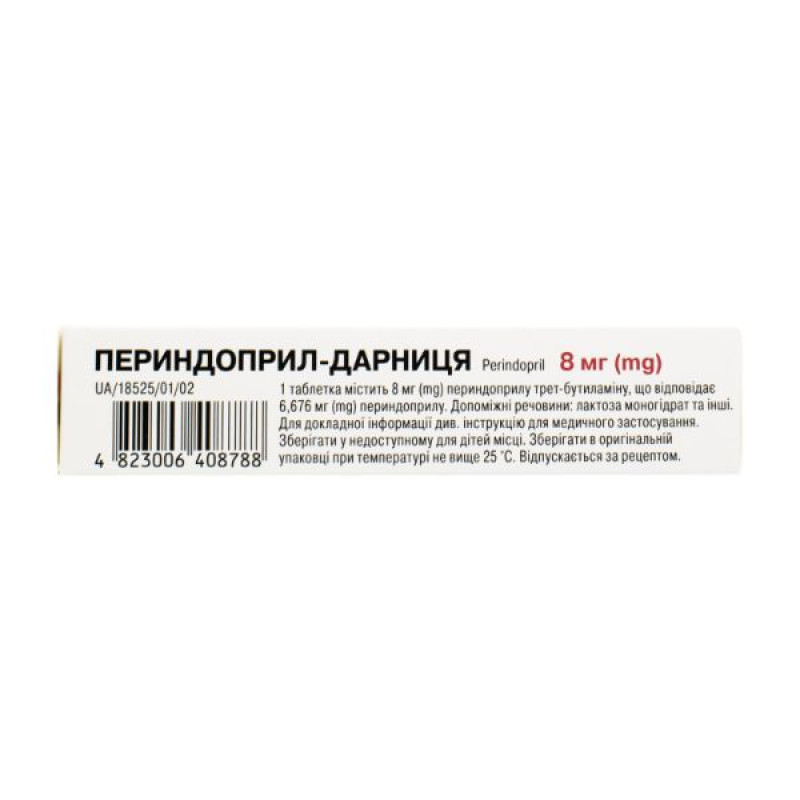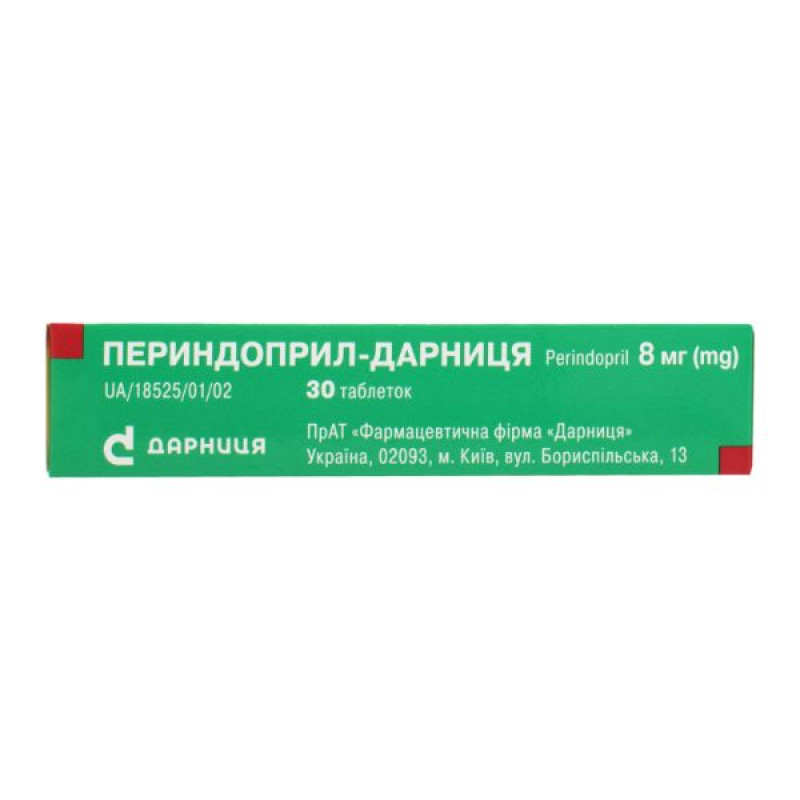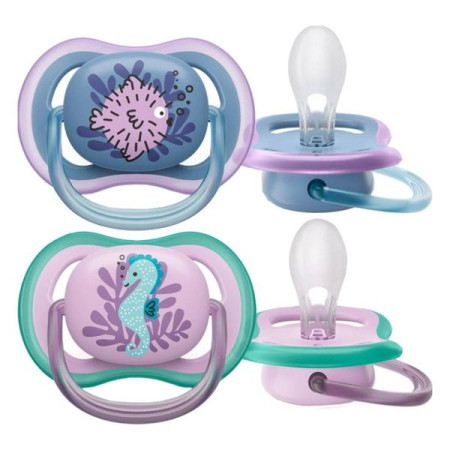Perindopril tablets 8 mg No. 30

The drug "Perindopril-Darnitsa" is used for the following indications:
arterial hypertension; heart failure; prevention of recurrent stroke in patients with cerebrovascular disease; prevention of cardiovascular complications in patients with documented stable ischemic heart disease.Long-term treatment reduces the risk of myocardial infarction and heart failure (according to the results of the EUROPA study).
Composition
Active ingredient: perindopril.
1 tablet contains 4 mg or 8 mg of perindopril tert-butylamine, which corresponds to 3.338 mg or 6.676 mg of perindopril.
Excipients: lactose monohydrate; microcrystalline cellulose; colloidal hydrophobic silicon dioxide; magnesium stearate.
Contraindication
Hypersensitivity to the active substance or to any of the excipients of the medicinal product, or to any other ACE inhibitor.
History of angioedema after use of an ACE inhibitor.
Idiopathic or hereditary angioedema.
Concomitant administration with medicinal products containing the active substance aliskiren to patients with diabetes mellitus or renal insufficiency (GFR < 60 ml/min/1.73 m2).
Pregnancy or the period of pregnancy planning.
Concomitant use with sacubitril/valsartan.
Extracorporeal treatments that bring blood into contact with negatively charged surfaces.
Significant bilateral renal artery stenosis or stenosis of the artery to a single functioning kidney.
Method of administration and doses
For oral use.
Perindopril-Darnitsa 4 mg and 8 mg tablets can be divided in half to achieve doses of 2 mg and 4 mg.
It is recommended to take the tablets once a day in the morning before meals.
The dose should be selected individually, depending on blood pressure indicators.
Arterial hypertension.
Perindopril tert-butylamine can be prescribed as monotherapy or in combination with drugs from other classes of antihypertensive agents.
The recommended starting dose is 4 mg once daily in the morning.
Patients with high RAAS activity (especially patients with renovascular hypertension, electrolyte imbalance, cardiac decompensation or severe hypertension) may experience excessive reduction in blood pressure after the first dose. In such patients, it is recommended to start treatment with a dose of 2 mg and initiate therapy under medical supervision.
The dose may be increased to 8 mg once daily after 1 month of treatment.
Symptomatic hypotension may occur at the beginning of treatment with perindopril tert-butylamine; this is more likely in patients who are taking diuretics. In such patients, treatment with perindopril should be initiated with caution, as they may be water and/or salt depleted.
If possible, the diuretic should be discontinued 2-3 days before starting perindopril tert-butylamine therapy.
In patients with hypertension who cannot discontinue diuretics, treatment should be initiated with a dose of 2 mg. In such patients, renal function and serum potassium should be monitored. Further increases in the dose of perindopril tert-butylamine should be based on blood pressure measurements. Diuretic therapy may be resumed if necessary.
Elderly patients should start treatment with a dose of 2 mg, which may be increased to 4 mg after 1 month of treatment, and then, if necessary, to 8 mg, taking into account renal function.
Heart failure.
In patients with heart failure, in whom perindopril tert-butylamine should usually be administered concomitantly with a potassium-sparing diuretic and/or digoxin and/or a β-blocker, it is recommended that treatment be initiated under close medical supervision and with an initial dose of 2 mg, to be taken in the morning. After 2 weeks, if well tolerated, the dose may be increased to 4 mg once daily. The dose should be individualised, depending on the clinical condition of the patient.
In patients with severe heart failure and other high-risk patients (patients with impaired renal function and a tendency to electrolyte disturbances, patients receiving concomitant therapy with diuretics and/or vasodilators), treatment should be initiated under close medical supervision.
In patients at high risk of symptomatic hypotension (patients with electrolyte depletion, with or without hyponatremia, patients with hypovolemia, or those receiving intensive diuretic therapy), these conditions should be corrected, if possible, before prescribing the drug. Blood pressure, renal function, and serum potassium should be closely monitored both before and during treatment.
Prevention of recurrent stroke in patients with cerebrovascular disease.
The recommended initial dose is 2 mg (½ tablet of the drug "Perindopril-Darnitsa" 4 mg) 1 time per day, in the morning. After 2 weeks of treatment, the dose should be increased to 4 mg (1 tablet of the drug "Perindopril-Darnitsa" 4 mg) 1 time per day in the morning.
Prevention of cardiovascular complications in patients with documented stable coronary heart disease.
Treatment should be started with the drug "Perindopril-Darnitsa" 4 mg (1 tablet per day, in the morning). After 2 weeks, provided it is well tolerated and taking into account kidney function, the dose should be increased to 8 mg.
Elderly patients should start treatment with a dose of 2 mg (½ tablet of the drug "Perindopril-Darnitsa" 4 mg) once a day, in the morning; after a week, the dose should be increased to 4 mg (1 tablet of the drug "Perindopril-Darnitsa" 4 mg); after 2 weeks, taking into account kidney function, the dose should be increased to 8 mg ("Perindopril-Darnitsa" 8 mg, 1 tablet per day). Increasing the dose is possible only if the previous dose is well tolerated.
Application features
Children
The efficacy and safety of the drug in children have not been studied, therefore perindopril tert-butylamine is not recommended for use in children.
Pregnant women
The medicine should not be used by pregnant women or women planning to become pregnant.
Drivers
Perindopril tert-butylamine has no direct influence on the ability to drive or use machines. However, some patients may experience individual reactions associated with a decrease in blood pressure, especially at the beginning of treatment or when used simultaneously with other antihypertensive drugs. As a result, the ability to drive or use machines may be impaired.
Overdose
There is insufficient information on perindopril overdose. Possible symptoms associated with an overdose of ACE inhibitors: hypotension, circulatory shock, electrolyte imbalance, renal failure, hyperventilation, tachycardia, palpitations, bradycardia, dizziness, anxiety, cough, etc.
In case of overdose, intravenous administration of 0.9% sodium chloride solution (9 mg/ml) is recommended. In case of hypotension, the patient should be placed in a horizontal position with a low head. If possible, the patient should be given angiotensin II infusion and/or intravenous catecholamines. Perindopril can be removed from the systemic circulation by hemodialysis. In case of bradycardia resistant to treatment, the use of an artificial pacemaker is indicated. It is necessary to establish constant monitoring of the main vital signs, electrolytes and serum creatinine concentrations.
Adverse reactions
The safety profile of perindopril is consistent with the safety profile of ACE inhibitors.
The most common adverse reactions observed during the use of perindopril in clinical studies: dizziness, headache, paresthesia, vertigo, visual disturbances, tinnitus, hypotension, cough, shortness of breath, abdominal pain, constipation, diarrhea, taste perversion (dysgeusia), dyspepsia, nausea, vomiting, itching, skin rashes, muscle cramps, asthenia.
Storage conditions
Store in the original packaging at a temperature not exceeding 25 ° C. Keep out of the reach of children.
Shelf life - 2 years.
There are no reviews for this product.
There are no reviews for this product, be the first to leave your review.
No questions about this product, be the first and ask your question.















